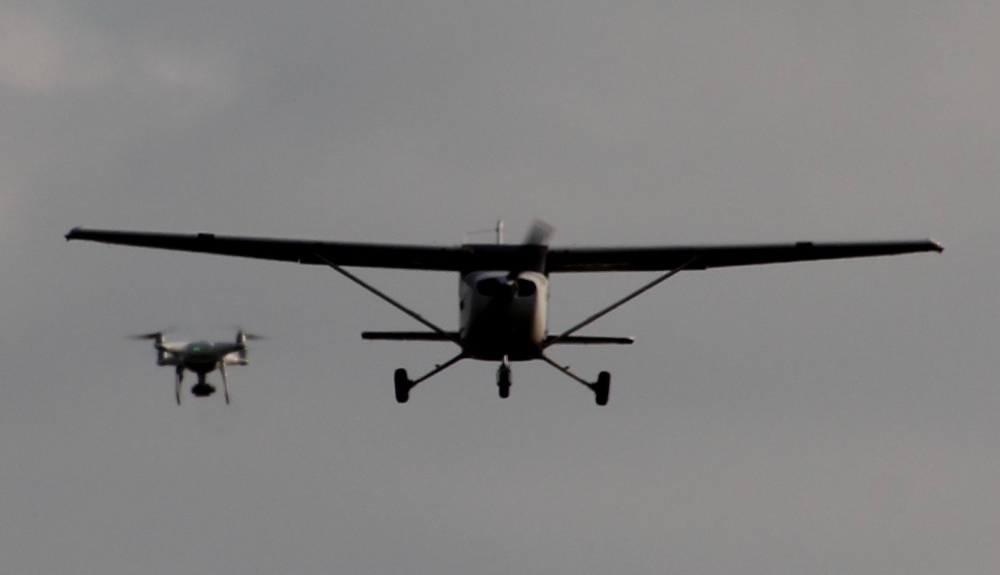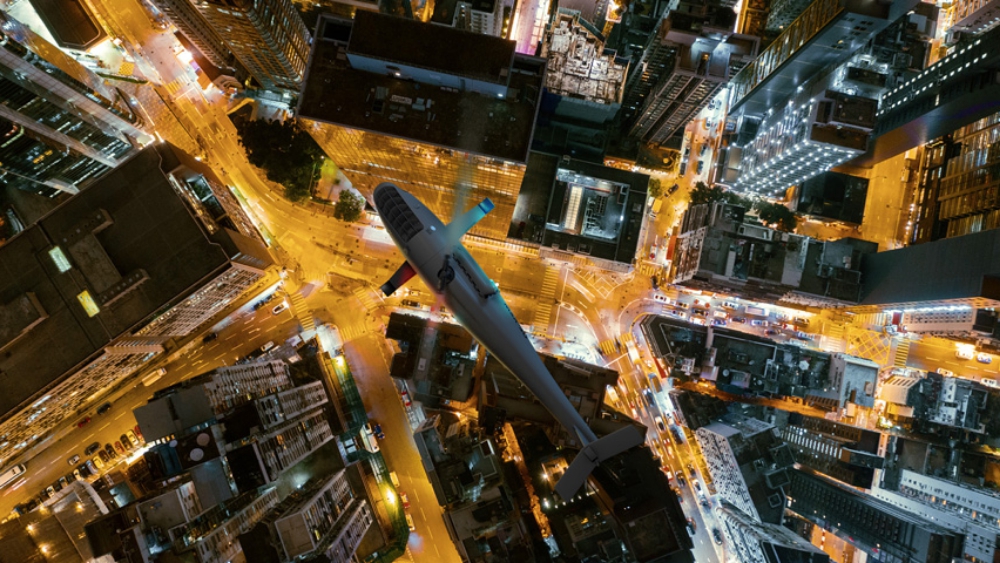torsdag 31. oktober 2019
Droner er vanskelige å oppdage fra fly - UAS Vision video
Encroaching Drones Usually Go Unseen by Pilots
Can you spot the drone in this video? The pilot of the aircraft could not see it.
Skilled pilots approaching a runway usually can’t see small unmanned aircraft systems (sUAS) encroaching on their airspace, and they virtually never detect motionless drones, a newly published study shows.
During an airborne human factors experiment, certificated pilots failed to see a common type of quadcopter during 28 of 40 close encounters, researchers with Oklahoma State University and Embry-Riddle Aeronautical University reported.
In other words, the pilots got a bead on the invading drone in 12 out of 40 cases, or only about 30 percent of the time. When the drone was not moving, the task became even more difficult. A mere three out of 22 motionless drones were spotted by the pilots. Drones were detected at distances of between 213 and 2,324 feet.
These findings, published in the International Journal of Aviation, Aeronautics, and Aerospace (IJAAA), illustrate a real and growing threat to aviation safety, said Dr. Ryan J. Wallace, assistant professor of Aeronautical Science at Embry-Riddle.
“Dangerous close encounters between aircraft and drones are becoming an increasingly common problem,” Wallace said. “Statistics on pilot sightings of drones continue to increase year over year, and what is being reported by pilots is probably just the tip of the iceberg. The vast majority of the time, unmanned aircraft are not being seen by pilots.”
Even in a best case scenario, if a drone was spotted at the study’s maximum detection range of 2,324 feet, the pilot would have only about 21 seconds to avoid a collision.
“That might be enough time if the drone was hovering in one spot, but not nearly enough if it’s in flight, headed for the aircraft,” said Dr. Matt Vance, assistant professor of aviation and space at Oklahoma State. “The situation is far more dangerous when both aircraft are moving,” he said. “Our eyes are attuned to movement. When a drone is not moving, it becomes part of the background.”
An aircraft’s final approach for landing is an especially risky time for a drone encounter because “it can catch you unaware and you have little time to react,” explained Dr. Jon M. Loffi, associate professor of aviation and space at Oklahoma State. “
You don’t have the altitude to manoeuvre safely, and if an engine ingests a drone, that could bring the aircraft down.”
The research examined what happens as a pilot prepares to land and switches from instrument-guided flight to visual flight. Pilot participants were selected from a collegiate flight-training program. During the experiment, pilots conducted an approach to landing in a Cessna 172S while a DJI Phantom IV quadcopter-type drone flew a scripted series of manoeuvres along the approach path. Pilots were told that they might or might not encounter a drone.
A Growing Problem
Currently in the United States, there are more than 1.4 million registered, and likely many more unregistered drones, and they continue to proliferate, Wallace said. Close calls between drones and commercial aircraft are on the rise. On Oct. 21, 2019, for example, a commercial crew on approach to Boston’s Logan International Airport reported a drone at about 3,500 feet above ground level – higher than U.S. Federal Aviation Administration (FAA) regulations allow. The event took place a week after another crew spotted a drone after takeoff from the same airport.
While the FAA “has made strides to secure control airspace from UAS incursions,” the study authors wrote, “their efforts have been met with mixed results.” There is currently no reliable method for tracking UAS flights within the United States.
The research team’s next project will involve rigging a drone with an electronic pinging device (UAvionics Ping), which uses ADS-B (automatic dependent surveillance-broadcast) technology to track aircraft. The study will assess whether the technology helps pilots pinpoint and avoid a collision with the drone.
Leveraging UAS remote identification data has been proposed as a way to reduce the risk of aircraft-drone accidents. As of January 2020, Vance noted, no aircraft will be allowed to fly in controlled airspace near airports without ADS-B tracking technology, but the law does not extend to small unmanned aircraft. If all drones had such technology, pilots would have a more complete picture of the skies around them, thereby improving safety, Vance said.
The study, “Cleared to Land: Pilot Visual Detection of Small Unmanned Aircraft During Final Approach” was co-authored by Wallace, Vance and Loffi, along with Jamey Jacob, Jared C. Dunlap, Tyler A. Mitchell, and Seabrook R. Whyte of Oklahoma State, as well as Robert Thomas of Embry-Riddle. The research can be found on the IJAAA website.
About Embry-Riddle Aeronautical University
Reporters worldwide contact Embry-Riddle Aeronautical University for content experts in all aspects of aviation, aerospace, engineering and STEM-related fields. Our faculty experts specialize in unmanned and autonomous systems, security and intelligence, air traffic and airport management, astronomy, human factors psychology, meteorology, spaceflight operations, urban air mobility and much more.
Embry-Riddle educates 34,000+ students at its residential campuses in Daytona Beach, Florida and Prescott, Arizona, at more than 135 Worldwide Campus locations and through the nation’s No.1 ranked online undergraduate degree programs
Photo : Oklahoma State University
UTM - Unmanned Traffic Management - Kongsberg er med i prosjekt som etterspørres av Avinor - UAS Vision
Kongsberg Geospatial and AiRXOS Partner on UTM
Kongsberg Geospatial, an Ottawa-based air traffic management company, and AiRXOS, part of GE Aviation, announced that AiRXOS has fully integrated the real-time airspace picture from the Kongsberg Geospatial IRIS airspace management application into the AiRXOS’ Air Mobility Platform for unmanned traffic management.
The Kongsberg Geospatial IRIS airspace management technology fuses multiple disparate, real-time sensor feeds to create a highly accurate airspace picture around critical infrastructure locations such as airports. This provides real-time calculation of aircraft separation, airspace monitoring alerts and communications line-of-sight prediction to enable detect and avoid for safe Beyond Visual Line of Sight (BVLOS) operations. This real-time local airspace picture is then integrated into the cloud-based AiRXOS’ Air Mobility Platform, a dynamic, cloud-based foundation, purpose-built for advanced operations and the evolving future of transportation.
The Air Mobility Platform manages the volume, density, and variety of Unmanned Traffic Management (UTM) data, and provides enterprises with a single platform to connect and manage operations, applications, and devices. Through this collaboration, the companies will provide UTM customers a best-in-class, fully integrated view of airspace for real-time airspace insights, and greater scalability, and repeatability of advanced operations.
“Situational awareness of the airspace across applications, Unmanned Aerial System (UAS) advanced operations, conformance monitoring, compliance, and pilots is critical to a UTM environment – allowing enterprises to be more responsive and efficient,” says Ken Stewart, CEO, AiRXOS. “Our partnership combines Kongsberg Geospatial’s expertise in airspace management with AiRXOS’ dynamic platform, applications, and services, providing customers with the opportunity to truly scale critical infrastructure advanced UAS operations like BVLOS and Multi-vehicle, helping to lower risk and increase savings.”“We’re very pleased to be working with an unmanned traffic management innovator like AiRXOS,” said Ranald McGillis, President of Kongsberg Geospatial. “Their ability to create a comprehensive surveillance view of operations and then to scale it for a nation-wide use provides an excellent and very unique use case for our technology.”
F-16C havarerte i USA - Curt Lewis
Lockheed Martin F-16C - Accident (New
Mexico)

Narrative:
A Lockheed Martin F-16C, asigned to the 49th Wing, crashed 80 miles from Alamogordo-Holloman AFB (HMN/KHMN), New Mexico, on a training flight and was destroyed.
The pilot ejected and was taken to hospital and later released.
/arc-anglerfish-arc2-prod-mco.s3.amazonaws.com/public/LGKFN7W2HJGNBL24YYF5MHFMDM.jpg)
https://aviation-safety.net/wikibase/230289

| Date: | 29-OCT-2019 |
| Time: | 19:16 |
| Type: | Lockheed Martin F-16C |
| Owner/operator: | US Air Force (USAF) |
| Registration: | |
| C/n / msn: | |
| Fatalities: | Fatalities: 0 / Occupants: 1 |
| Other fatalities: | 0 |
| Aircraft damage: | Written off (damaged beyond repair) |
| Location: | 80 miles from Alamogordo-Holloman AFB (HMN/KHMN), NM - United States of America |
| Phase: | En route |
| Nature: | Military |
| Departure airport: | Alamogordo-Holloman AFB, NM (HMN/KHMN) |
A Lockheed Martin F-16C, asigned to the 49th Wing, crashed 80 miles from Alamogordo-Holloman AFB (HMN/KHMN), New Mexico, on a training flight and was destroyed.
The pilot ejected and was taken to hospital and later released.
/arc-anglerfish-arc2-prod-mco.s3.amazonaws.com/public/LGKFN7W2HJGNBL24YYF5MHFMDM.jpg)
https://aviation-safety.net/wikibase/230289
MAX høringen - Dag 2 - Curt Lewis
737 Max Crashes: Boeing CEO Criticized for Lack of Pilot
Training, in Second Day of Testimony Dennis Muilenburg, chief executive officer of Boeing Co., speaks during a House Transportation and Infrastructure Committee hearing in Washington, D.C. regarding the two Boeing 737 Max crashes that killed 346 people. Lawmakers blasted Boeing and peppered its CEO on Wednesday with questions about the design and marketing of the 737 Max, the plane involved in two crashes that killed 346 people. House Transportation Committee Chairman Peter DeFazio, (D-Ore.), said Boeing showed a "lack of candor all through this." DeFazio and others on the panel highlighted Boeing's failure to tell pilots about a new flight-control system until after a Max crashed a year ago in Indonesia, and the recent disclosure a company test pilot raised alarms about the system in 2016. DeFazio and Rep. Steve Cohen, (D-Tenn.), also hammered CEO Dennis Muilenburg over his compensation, which rose last year to $23.4 million, including more than $13 million in extra incentive pay, according to a regulatory filing. Muilenburg explained changes Boeing is making in the Max and other steps it is taking to improve safety. He conceded the company "made some mistakes" in designing the flight system called MCAS, which pushed down the nose of the planes before crashes in Indonesia and Ethiopia. "We are learning, we still have more to learn, we have to work to do to restore the public's trust," Muilenburg said. Some members of the panel defended Boeing and the Federal Aviation Administration, which certified the plane. The committee's top Republican, Sam Graves of Missouri, said he wasn't absolving Boeing of mistakes but suggested foreign pilots were partly to blame. Graves noted the safety record of U.S. aviation-no fatal crashes since 2009-and a preliminary report on the second Max crash, which revealed the Ethiopian Airlines pilots were flying so fast it might have hindered their ability to overcome an MCAS malfunction. "I guess we're going to have to start building airplanes to the lowest common denominator...if we're going to export" planes, Graves said. The Transportation Committee has been investigating Boeing and the FAA for months, securing about 500,000 pages of documents, some of which they displayed at the hearing. The committee learned of a manager who said assembly-line workers were being pushed too hard to churn out 52 of the 737s a month in 2018, and he urged that production be stopped. He said he was hesitant to put his own family on a Boeing plane. Muilenburg said the manager, who has since retired, "raised some good concerns" that the company has addressed. However, Boeing didn't reduce the production rate until this April, when the grounding of the Max halted deliveries of new Max jets. Muilenburg's appearance before the House panel came a day after he testified to a Senate committee. He was criticized by senators over several issues, including failing to tell Congress and regulators about a senior test pilot's messages that seemed to raise alarms the new flight-control system. Boeing has been spending months revising MCAS, tying it to an additional sensor at all times and making it less powerful. The company hopes to win approval before year-end from the FAA to get the Max back in the air. Regulators in other parts of the world have indicated they may take longer to review Boeing's changes to the plane. After the hearings, Congress is likely to consider changes in how the FAA certifies new planes. https://fortune.com/2019/10/30/737-max-crashes-boeing-ceo-grilled-in-house-hearing-for-lack-pilot-training-mcas-flight-system/ Back to Top |
When asked if he'll resign in light of 737 MAX crashes,
Boeing CEO says 'that's not where my focus is' When asked if he'll resign in light of 737 MAX crashes, Boeing CEO says 'that's not where my focus is' originally appeared on abcnews.go.com Boeing CEO Dennis Muilenburg faced tough questions from lawmakers on Tuesday during his first appearance on Capitol Hill following the two crashes involving the 737 MAX jet that killed 346 people, including if he will or will not resign. "I'm focused on the job at hand. And I came to Boeing, because we care about building safe airplanes for the world. That's what it's always been about," Muilenberg said Oct. 29, before the Senate Committee on Commerce, Science and Transportation. "These two accidents occurred on my watch. And I have a keen sense of responsibility to see that through." Muilenberg brushed off the question on whether he will resign, adding "that's not where my focus is. My focus is on the job at hand focused on safety. And we're going to do everything we can ensure safe flight." The issue at hand highlights one argument from lawmakers that Boeing prematurely certified the aircraft before the pilots were fully trained on the newer MCAS automation system. Ranking Member Sen. Maria Cantwell pushed the CEO, asking why the company looks to have put profit over aviation safety. "We cannot have a race for commercial airplanes become a race to the bottom when it comes to safety," Cantwell, D-Wash., said. "The company cannot prioritize profits over safety. Safety always has to be job number one." Muilenburg reiterated that he was made aware of documents earlier in the year, and at that point he counted on his council to handle appropriately. After reviewing messages between technical pilots Patrik Gustavvson and Mark Forkner, Texas Sen. Ted Cruz took the issue a step further, calling out Boeing's leadership for potentially lying to regulators. "How in the hell did nobody bring this to your attention?" Cruz asked Muilenburg. "How did you just read this a couple weeks ago?" Muilenburg said he's not sure what Forkner meant in the exchange.  PHOTO: Survivors of those killed in the Ethiopian Airlines Flight 302 and Lion Air Flight 610 crashes hold photos of their family members behind Dennis Muilenburg, center, and John Hamilton, left, on Capitol Hill in Washington, Oct. 29, 2019. (Andrew Harnik/AP) GOP Chairman Sen. Roger Wicker, from Mississippi, and Cantwell alike grilled Muilenberg on how the company let this happen and what they've done to ensure it doesn't happen again. "It's something that we've spent a lot of time thinking about over the last ... over the last year. We have a keen sense of responsibility. We're responsible for our airplanes. And any accident, any accident with one of our airplanes is not acceptable," Muilenburg said in his testimony. "And we reviewed both of these accidents, we know what needs to be fixed. We own that. We have a responsibility to do that. We know we made mistakes and got some things wrong. We own that, and we are fixing them." He added, "We're never going to stop focusing on safety and continuously improving." Muilenburg laid out the plan for Boeing's improvements to the now grounded 737 MAX. "We're confident with the updates that we're making that once the MAX returns to the skies, it'll be one of the safest airplanes ever fly," he said.  PHOTO: Sen. Richard Blumenthal in the Hart Senate Office Building on Capitol Hill in Washington, D.C., Oct. 29, 2019. (Mandel Ngan/AFP via Getty Images) Still, some lawmakers were less than impressed with the CEO's response to the crashes. Connecticut Sen. Richard Blumenthal highlighted an email from Forkner, the chief technical pilot for the Boeing 737 MAX, where it showed Muilenburg's awareness that Boeing didn't include a reference to the MCAS system in the aircraft operating manual. "Boeing came to my office and said this was the result of pilot error, those pilots never had a chance, victims never had a chance, they were in flying coffins," Blumenthal said. Muilenberg said the decision to not include a reference in an operating manual is not determined by one individual. Blumenthal added, "Would you agree that this system over oversight is broken? That's the lesson here, isn't it?" "My anger has only grown" Blumenthal said, asking victims to hold up photos of their loved ones that were lost. "Loved ones lost lives because of an accident that was preventable, that was the result of a pattern of deliberate concealment." The National Transportation Security Board issued and identified three major suggestions during their investigation, including issues related to alerts, system improvements and reaction to alarms. NTSB Chairman Robert Sumwalt told lawmakers that it was clear the MCAS was not working and they sent out an advisory -- which included the impact multiple flight deck alerts could've had on the pilot's responses. However, the alerts weren't considered explicit enough. House Transportation and Infrastructure Committee Chair Rep. Peter DeFazio, D-Ore., told ABC News that he will ask Muilenburg why Boeing did not identify issues "before the plane ever flew" during the House Committee hearing on Wednesday. The committee intends to focus on production pressures inside Boeing, pilot training requirements, concealing data from regulators and FAA oversight, according to a committee spokesperson. DeFazio says the committee has received as part of its investigation "report after report about production pressures" inside Boeing. "I fear that profit took precedence and put pressure on the whole organization all the way down," DeFazio said in an interview with ABC News' Senior Transportation Correspondent David Kerley. Boeing's safety culture has been under increased scrutiny since messages surfaced two weeks ago in which Forkner told another pilot that the MCAS flight control system was "running rampant" in a simulator session. The Maneuvering Characteristics Augmentation System (MCAS) is a software feature introduced in the 737 MAX so that it feels and flies like previous models, according to Boeing. Reports from investigators indicate that the misfiring of MCAS repeatedly pushed the planes' noses down during the fatal Lion Air and Ethiopian Air crashes. Other documents released by the House Committee show Forkner told Federal Aviation Administration officials that MCAS was safe after calling it "egregious" based on simulator tests, according to internal messages and emails. In regards to areas like pilot training and manual recommendations, Forkner was the main point of contact between the FAA and Boeing, an FAA official explained. Boeing's goal was for the transition to be so seamless from their old plane, the 737 Next Generation, to the 737 MAX that it would not require any additional simulator training for pilots. Boeing said in a statement that Forkner was not referring to the MCAS system in the internal messages, but that "his comments reflected a reaction to a simulator program that was not functioning properly, and that was still undergoing testing." Lawmakers and regulators say they initially did not have access to these internal messages. After receiving them, the FAA said in a statement that it found the messages disturbing and that it was "disappointed that Boeing did not bring this document to [their] attention immediately upon its discovery." The same day that the messages and emails were released, DeFazio sent a letter to U.S. Secretary of Transportation Elaine Chao saying the "messages indicate that Boeing withheld damning information from the FAA, which is highly disturbing." DeFazio said the concealment of information could lead to criminal charges. "I would say deliberate concealment would be a criminal act," DeFazio said. "We can't say that it was deliberately concealed definitively at this point." But DeFazio said that he is focusing on what he does know, which is that the aircraft certification policy needs to change. Under the Organization Designation Authorization (ODA) program mandated by Congress, some of the certification process is delegated to manufacturers like Boeing. Critics of the ODA program say it's a conflict of interest that Boeing was able to influence the certification of the 737 MAX. However, some defend the program and say that there is sufficient FAA oversight from start to finish during the aircraft certification process. In 2003, DeFazio voted against the initial bill that mandated the ODA program. "The system is going to change," DeFazio said. Joint Authorities Technical Review Slams FAA Boeing Max8 Certification Process JAMES T. CROUSE  On October 11, 2019, the Joint Authorities Technical Review (JATR) consisting of representatives from the FAA, NASA, and Civil Aviation Authorities (CAA's) from Australia, Brazil, Canada. China, Europe, Indonesia, Japan, Singapore and the UAE, submitted its report to the FAA's Associate Administrator for Aviation Safety. In short, it is a broad condemnation of the FAA's aircraft certification process and its twelve recommendations call for a wholesale review and modification of the entire certification process. Its recommendation are meaningful and timely; the FAA should embrace the report and adopt all of the recommendations. In a single sentence in his cover letter accompanying the report, Christopher Hart, former NTSB chair and Chairman of the JATR, summed up what many of us in aviation have known for years. After noting that systems have become more complex and making it more likely regulations and standards would not address every conceivable scenario, Hart stated: "To the extent that they do not address every scenario, compliance with every applicable regulation and standard does not necessarily ensure safety." (emphasis added). The Report continued to suggest that the Organization Designation Authorization Program, or ODA (interesting changed acronym from its previous "DOA"), the program by which the FAA grants the manufacturer/designer, in this case Boeing, authority over the certification project, is weak due to inadequate CAA oversight. The JATR team concluded that FAA resources fall short which may have contributed to an "inadequate number of FAA specialists being involved in the B737 MAX certification program." In short, the FAA was incapable to oversee Boeing's activities due to a lack qualified engineers and technical expertise. Specifically, as to the highly problematical and deadly Maneuvering Characteristics Augmentation System (MCAS), the reported stated that the FAA "had inadequate awareness of the MCAS function which, coupled with limited involvement, resulted in the inability of the FAA to provide an independent assessment of the adequacy of the Boeing proposed certification activities associated with the MCAS." This inadequacy, coupled with the Boeing test pilots' failure to be candid with the FAA when they encountered problems with the MCAS system during flight simulator tests (addressed in a subsequent article), made it almost certain that the FAA would not discover the fatal flaws in the MCAS. Of the many findings and recommendations made by this panel, none is more important than its emphasis on a holistic aircraft certification process. Given the complexity of modern aircraft, it is important that any modification be evaluated in relation to the entire aircraft. A change to one components or system can have unintended and dramatic consequences to the aircraft system as a whole. Hence, no more piecemeal alterations looking solely at that particular aspect of the aircraft and no more layer upon layer of changes to an already existing, sometimes much older platform that in some cases bears little relation to the original type-certificated model. Other certification aspects addressed in the report include making sure that all operational aspects of design changes are considered in operations and training, the different operating environments between manufacturer engineering test pilots and operational test pilots, post-certification follow-up and monitoring of design changes. 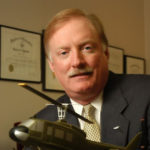 James T. Crouse James T. Crouse has been a pilot for thirty-two years, during which time he has performed as a U.S. Army aircraft maintenance officer, maintenance test pilot, and research and development test pilot. Mr. Crouse has litigation experience involving major air carriers, general aviation, helicopter, and military crashes, as well as non-aviation mass disaster litigation. GE still sees $1.4 billion cash cost from Boeing 737 MAX grounding in 2019  FILE PHOTO: The logo of U.S. conglomerate General Electric is seen on the company building in Belfort NEW YORK (Reuters) - General Electric Co still expects the grounding of Boeing Co's 737 MAX jetliner to reduce its cash flow by $1.4 billion in 2019, provided the aircraft remains grounded all year, GE Chief Executive Larry Culp said during a conference call on quarterly earnings on Wednesday. GE and French partner Safran SA make engines for the jet. "As we think about 2020, I think we're going to try to follow Boeing's lead here," Culp said, responding to an analyst question. "When we talk about the full-year cash headwinds this year due to MAX, that, obviously, assumes that we don't see a return to service this year," he said. He added the forecast is conservative. GE's chief financial officer, Jamie Miller, said GE still expects "the year to be impacted to the tune of about negative $1.4 billion." She said it was "difficult to predict" the financial impact on GE in 2020 and beyond. Boeing has said it expects the jet to clear approval by U.S. regulators by year-end. Global aviation regulators grounded the jet after a second fatal crash last March. |
Boeing har problemer med B737NG serien - ABC Nyheter / Curt Lewis
Kriserammede Boeing har satt rundt 50 737 NG-fly
på bakken grunnet sikkerhetsbekymringer etter at det ble funnet sprekker ved
flyets vinger.
NTB
31. okt. 2019 06:35 – Oppdatert
31. okt. 2019 06:35
Flyene
er satt på bakken etter at USAs luftfartsmyndighet tidlig i oktober beordret at
flyene skulle undersøkes grunnet funn av sprekker på fly i Kina.
Til
nyhetsbyrået AFP opplyser en talsperson for Boeing at rundt 1.000 fly hittil
har bestått inspeksjonen, med «funn» på mindre enn fem prosent, altså rundt 50
fly.
Flyene
er en versjon av typen Boeing 737 kalt NG, som er forkortelse for neste
generasjon. Boeing planlegger å erstatte NG med MAX-flyene, som alle for tiden
er satt på bakken etter de to MAX 8-ulykkene i Indonesia i oktober i fjor og
Etiopia i mars der til sammen 346 mennesker mistet livet.
Qantas grounds Boeing 737 plane with crack, inspects
others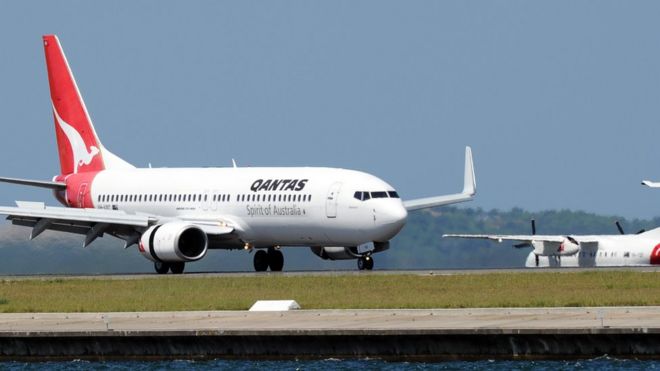
Qantas has grounded one Boeing 737NG due to a crack and is urgently inspecting 32 others (AFP Photo/Saeed KHAN)
Sydney (AFP) - Australian flag carrier Qantas said Thursday it had grounded one Boeing 737NG due to a structural crack, and was urgently inspecting 32 others for the flaw.
The grounding is the latest safety concern for Boeing, as it reels from two 737 MAX crashes that killed 346 people and highlighted problems with the planes' flight handling software.
The US aviation authority this month ordered checks of Boeing 737NG planes that had flown more than 30,000 times.
That came after the company reported the "pickle fork", which helps connect the wing to the fuselage, could be prone to cracking.
Qantas said Thursday it had found the fault in a more lightly used aircraft, one that had recorded fewer than 27,000 flights.
"This aircraft has been removed from service for repair," Qantas said in a statement, adding it had hastened its inspections of 32 other 737NG plans to be completed by Friday.
The announcement by Qantas raised fears the cracking issue could affect newer planes than previously thought, leading to calls for the Australian airline to ground its entire 737 fleet.
"These aircraft should be kept safe on the ground until urgent inspections are completed," an engineers' union representative, Steve Purvinas, said in a statement.
However Qantas described the call to ground its 737 fleet as "completely irresponsible".
"We would never operate an aircraft unless it was completely safe to do so," Qantas head of engineering Chris Snook said.
"Even when a crack is present, it does not immediately compromise the safety of the aircraft."
The FAA initially said Boeing notified the agency of the problem after encountering the issue on a plane in China and that subsequent inspections showed other planes also had cracks.
The NG is a precursor plane to the Boeing 737 MAX, which has been grounded since mid-March following the two deadly crashes in Indonesia and Ethiopia.
Boeing chief executive Dennis Muilenburg faced another round of tough questions on Wednesday from US lawmakers who accused the company of a "lack of candour" over the crashes.
onsdag 30. oktober 2019
USA og Tyler Rogoway er interessert i det som skjer i Norskehavet nå
One of the participants: Akula Class
The most extensive Russian
underwater exercise since the end of the Cold War is currently underway in the
frigid waters of the North Atlantic. No less than 10 Russian Navy submarines
are reported to be involved, eight of which are nuclear powered, according to
Norwegian intelligence.
The massive exercise is thought to
include tests of new weapons and
stressing of capabilities of individual classes of submarines involved,
including long-duration, deeply submerged operations. The exercise is also
likely to test U.S. and NATO forces' ability to track Russia's most capable
boats as they push through the Greenland, Iceland, United Kingdom Gap, better
known as the GIUK Gap—a major strategic bottleneck that is closely monitored.
If Russian submarines can break through undetected, they have a far better
chance of disappearing into the Atlantic to go about their potentially very
deadly business without being traced. During a time of war, this can include
wreaking havoc on Allied shipping and naval flotillas and executing pinpoint
attacks on key land targets.
Norwegian news outlet NRK,
which originally broke the story, states that Norwegian intelligence thinks it
has a decent idea of where at least some of the submarines currently are, but
this could change as the exercise could last as long as two months. The Barents Observer has
the areas listed:
·
Two nuclear submarines are west of the
Bear Island, between Svalbard and Finnmark, the northernmost part of mainland
Norway.
·
Two submarines are south and east of
the Bear Island, guarding the entrance to the eastern part of the Barents Sea.
·
Two Sierra class nuclear
submarines are training in the northern part of the Norwegian Sea.
The Sierra II class is among
Russia's most capable fast attack submarines, with their titanium hulls capable
of withstanding greater depths than their steel counterparts. They are known to
be extremely quiet, as well.
Unknown source via HIsutton.com
Sierra
II class SSN.
Also noted by NRK are the
assumed goals of the large-scale drill (translated):
"The goal for some of the
submarines is to get as far out into the Atlantic as possible without being
discovered. The entire voyage from the Northern Fleet bases in the Murmansk
region has been submerged... Russia's goal is to show that they are able to threaten
the US East Coast... Russia wants to say that "this is our sea", we
can do this. We are able to reach the United States... They want to test the
West's ability to detect and handle this..."
CIA.gov
GIUK Gap map from the Cold
War.
Russian submarines could also flood
into the GIUK Gap and the waters off Norway in a defensive posture to keep
American submarines and surface combatants from pushing northward during a
crisis. This would protect strategic Russian naval ports on the Barents Sea,
Russia's ballistic missile boats patrolling
the northernmost latitudes and hiding under the polar icecap, and its
increasingly strategic territorial holdings in the
Arctic.
After decades of atrophy, the U.S. and
its allies are slowly rebuilding their anti-submarine warfare capabilities in
and around the GIUK Gap. Most notably, the US Navy has bolstered its detachment of P-8 Poseidon
maritime patrol aircraft that operate out of Iceland. The US Navy has also reactivated the 2nd Fleet
and has greatly increased patrols
and exercises in the North Atlantic.
Still, if a number of Russian
submarines, including some of the country's most elusive types, push south
suddenly during the exercise, the U.S. and its allies may be very hard-pressed
to keep track of all of them. This all comes at a time when America's own
submarine force is overtasked, as well. No
matter how powerful a high-end nuclear fast attack submarine is, it can only be
in one place at one time, and that place is the pier more often than not. Other U.S. and Allied naval assets
with anti-submarine capabilities aren't exactly in great supply either.
Good news from RAF
Good news from RAF
There is some good news in terms of
extra help with keeping tabs on submarines in the North Atlantic coming in the
not so distant future. The United Kingdom received the first of nine Poseidon MRA Mk1 (P-8A) Poseidons today. Once
the fleet of aircraft is fully operational, it will plug a long-standing gap in
the UK's maritime patrol capability and could help greatly in monitoring and
hunting for Russian submarines pushing south through the GIUK Gap.
Forsvarsministeren inviterer til dialogmøter - Regjeringen
Forsvarsministeren vil ha innspill til ny langtidsplan for Forsvaret
Pressemelding | Dato: 30.10.2019
Forsvarsminister Frank Bakke-Jensen vil ha innspill til arbeidet med en ny langtidsplan for forsvarssektoren, og inviterer til dialogmøter i Oslo 12. november og i Tromsø 26. november.
- Når vi skal lage en ny langtidsplan for Forsvaret er det viktig med ulike perspektiver. Jeg inviterer alle de som har en interesse i den nye langtidsplanen til å komme med både skriftlige innspill og delta på dialogmøter, sier forsvarsminister Frank Bakke-Jensen.
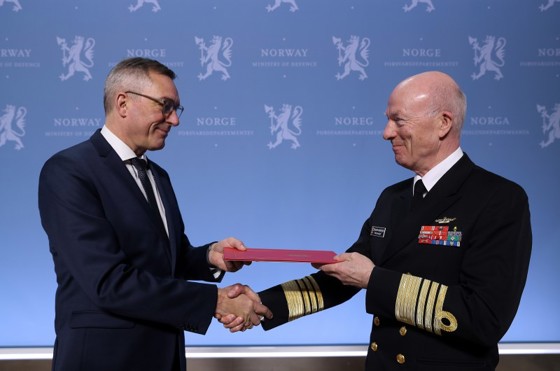
Forsvarssjefen har nylig presentert sitt fagmilitære råd til arbeidet med ny langtidsplan for forsvaret. Interessenter, organisasjoner og andre berørte bes om å komme med skriftlige innspill på det fagmilitære rådet innen fredag 1. november 2019.
Det blir rom for å utdype innspillene på dialogmøter i Oslo og Tromsø, med et innlegg på inntil fem minutter. Møtene vil foregå på dagtid i Oslo (Forsvarsdepartementet) 12. november og i Tromsø (Forskningsparken) 26. november.
Alle som har innspill eller ønsker å delta på et av dialogmøtene bes om å sende en epost til langtidsplan@fd.dep.no
Piper med nydelig maskin - Piper video
VERO BEACH, FL., October 30, 2019 – Piper Aircraft announced today, the next generation M Series aircraft – the M600 SLS, standard equipped with the new HALO™ Safety System – enhancing Safety, Luxury, and Support for one of the world’s leading personal use, Basic Med compliant aircraft. It will now also be the first general aviation aircraft in the world to be certified with Autoland capability.
SAFETY
The HALO™ Safety System is a compilation of innovative technologies unique to the M600 SLS and the Garmin G3000 avionics suite. The system includes Auto-throttle, Emergency Descent Mode, Enhanced Stability and Protection, Surface Watch, Safe Taxi, Flight Stream connectivity and more. However, of greatest significance is the addition of Garmin Autoland – digital technology that safely lands the aircraft at the nearest suitable airport in the event that the pilot is incapacitated.
The HALO™ Safety System is a compilation of innovative technologies unique to the M600 SLS and the Garmin G3000 avionics suite. The system includes Auto-throttle, Emergency Descent Mode, Enhanced Stability and Protection, Surface Watch, Safe Taxi, Flight Stream connectivity and more. However, of greatest significance is the addition of Garmin Autoland – digital technology that safely lands the aircraft at the nearest suitable airport in the event that the pilot is incapacitated.
The Halo system, once engaged either automatically or by a passenger, gains immediate situational awareness and assumes control of all systems necessary to bring you and your passengers safely to the best suited runway. During all phases of flight it communicates with passengers and appropriate air traffic control facilities regarding the new flight plan route and estimated time until landing. Halo continually monitors all aircraft system parameters and real-time external inputs as if the pilot were at the controls. It takes into account runway size and orientation, wind, time, fuel range, glide path and considers weather conditions and terrain en route to the nearest suitable runway. Once Halo has landed the aircraft, the braking system will activate and will bring the aircraft to a full and complete stop. Finally, the engine will shut down and instructions will be provided on how to exit the aircraft.
LUXURY
The M600 SLS raises the bar in Luxury with the addition of the EXP interior package as standard equipment. The interior package was designed with a focus on the personal travel experience and enables the customer to select from sophisticated interior color palettes with custom materials, stitching patterns and contrasting threads. Veneer and trim finishes further enhance the sense of unmatched refinement. Additionally, thoughtfully designed interior options, like two toned leather seats and Alcantara fabric have been added to elevate the passenger experience.
The M600 SLS raises the bar in Luxury with the addition of the EXP interior package as standard equipment. The interior package was designed with a focus on the personal travel experience and enables the customer to select from sophisticated interior color palettes with custom materials, stitching patterns and contrasting threads. Veneer and trim finishes further enhance the sense of unmatched refinement. Additionally, thoughtfully designed interior options, like two toned leather seats and Alcantara fabric have been added to elevate the passenger experience.
SUPPORT
Ownership of a M600 SLS is backed by an exclusive service program for the first five years of ownership. The Ultimate Care Program includes all scheduled maintenance, as well as hourly and calendar-based inspections.
Ownership of a M600 SLS is backed by an exclusive service program for the first five years of ownership. The Ultimate Care Program includes all scheduled maintenance, as well as hourly and calendar-based inspections.
“The M600 SLS and its HALO™ Safety System with Autoland is the result of an unwavering commitment to safety as well as the desire to evolve our products based on market input, said President and CEO, Simon Caldecott. “The HALO System greatly enhances situational awareness and operational safety through the use of advanced technology and is one the most significant advancements in General Aviation history. The team at Piper Aircraft is proud that we will be first to market with Garmin Autoland, which will ultimately help pave the way for others.”
Certification of the M600 SLS is imminent with deliveries beginning this quarter through the global Piper Dealer network at a price point of $2.994M.
About Piper Aircraft
Piper Aircraft Inc., headquartered in Vero Beach, Fla., offers aviators throughout the world efficient and reliable single- and twin-engine aircraft and is the first general aviation aircraft manufacturer in the world to certify Garmin Autoland The single-engine M-Class series – the M600SLS, M500, and M350 – offers businesses and individual’s elegant performance, value and a superior ownership experience. The Personal Class Seneca V, Archer LX and Archer DLX balance proven performance, efficiency, and simplicity in a piston powered aircraft. The Trainer Class Pilot 100/100i, Archer TX, Archer DX, Arrow, Seminole and Seneca V aircraft form the most complete technically-advanced line of pilot training aircraft in the world. Piper is a member of the General Aviation Manufacturers Association. To learn more about Piper Aircraft, visit the company’s website at www.piper.com.
Japans F-15J blir Super Interceptor - Tyler Rogoway

The U.S. government has
approved the potential sale of a major upgrade package for a significant
portion of Japan's F-15J Eagle fleet that would
bring them up to a standard called the Japanese Super Interceptor, or JSI. Jets
in this configuration would get new active electronically
scanned array radars, improved mission computers, updated electronic
warfare suites, and more.
The U.S. State Department
approved the sale on Oct. 29, 2019, and the U.S. military's Defense Security
Cooperation Agency (DSCA) subsequently notified Congress and issued a public notice. The possible deal, which
covers 98 of the Japan Air Self Defense Force's around 200 F-15Js, has an
estimated value of $4.5 billion. It is important to note that this announcement
does not automatically mean that the Japanese government will actually proceed
with this purchase and that it would also have to negotiate the final terms of
any relevant contracts. That being said, Japan has been publicly looking to
upgrade at least a portion of its F-15J fleet for over a year and 2previous reports have already indicated
the country's preference for many of the systems described in the DSCA
announcement, including Raytheon's AN/APG-82(V)1 active
electronically scanned array (AESA) radar and BAE Systems' AN/ALQ-239 Digital Electronic
Warfare System (DEWS).
GA havari i USA - ASN
| Date: | 29-OCT-2019 |
| Time: | 11:00 |
| Type: |  Cessna 414A Chancellor |
| Owner/operator: | Warbird Associates Inc |
| Registration: | N959MJ |
| C/n / msn: | 414A0471 |
| Fatalities: | Fatalities: 1 / Occupants: 1 |
| Other fatalities: | 0 |
| Aircraft damage: | Written off (damaged beyond repair) |
| Location: | Woodbridge township, Colonia, NJ -  United States of America United States of America |
| Phase: | Approach |
| Nature: | Private |
| Departure airport: | Leesburg Executive Airport, VA (JYO/KJYO) |
| Linden Airport, NJ (LDJ/KLDJ) |
A Cessna 414A Chancellor (RAM mod.) crashed into houses in Woodbridge township, Colonia, New Jersey. At least three were set on fire and the aircraft was destroyed.
The pilot didn't survived the crash.
Betydelig lavere pris for F-35 de neste årene - Regjeringen
Betydelig prisreduksjon for våre nye F-35 kampfly de neste årene
Pressemelding | Dato: 29.10.2019
En ny avtale mellom det flernasjonale programkontoret for F-35 og flyprodusenten Lockheed Martin medfører at enhetsprisen for de norske F-35 kampflyene går ned med om lag 10 prosent. – Enhetsprisen for F-35 ligger dermed under våre tidligere prognoser. Kostnadsreduserende tiltak, gode forhandlinger og samarbeid i et partnerskap viser nå resultater. Det er veldig positivt og styrker vår tillit til anskaffelsen, sier forsvarsminister Frank Bakke-Jensen.
– Kampflyene leveres på tid, med bedre ytelse enn forventet og med en lavere enhetspris enn planlagt, sier forsvarsministeren.
Den gjennomsnittlige enhetsprisen for de neste 18 kampflyene Norge vil få levert i de tre neste årene blir på om lag 81,6 mill. amerikanske dollar. Flyene som landet på Ørlandet i september i år hadde enhetspris på 90,2 mill. amerikanske dollar.

Lavere enhetspriser på våre neste kampfly
Gjennom forhandlingene det flernasjonale partnerskapet har gjennomført med Lockheed Martin og Pratt & Whitney har vi oppnådd betydelig lavere enhetspriser enn det som var estimert. De norske flyene er om lag 1,5 mill. dollar dyrere enn de amerikanske kampflyene. Dette skyldes installasjon av norsk programvare, norske merker på flyene, samt at de norske flyene har bremseskjerm.
Kontrakten omfatter til sammen 478 F-35 kampfly for produksjonsserie 12, 13 og 14. 18 av disse flyene er norske. Verdien på kontrakten er om lag på 34 mrd. dollar. Norge fikk gjennom behandlingen av Prop. 1 S (2015-2016) samt Prop. 1 S (2016-2017) fullmakt til å bestille produksjonsseriene 12-14 som en samlet bestilling i den hensikt å redusere enhetsprisen for flyene.
– Jeg er veldig fornøyd med at vi i forhandlinger sammen med våre partnerland har klart å oppnå målet om å kutte enhetskostnadene på kampflyene ytterligere. Dette viser fordelen ved å være del av et stort partnerskap, sier Bakke-Jensen.

Utvikling av prisene over tid
De første flyene Norge fikk levert i 2015 hadde en enhetspris på 114,1 mill. amerikanske dollar og flyene som landet på Ørlandet i september i år hadde enhetspris på 90,2 mill. dollar. De norske enhetsprisene for de tre produksjonsseriene utgjør i gjennomsnitt 81,6 mill. dollar. Prisen omfatter fly og motor.
I november 2017 landet de tre første F-35 kampflyene på norsk jord. Til sammen har Norge nå mottatt 22 F-35. Av disse opererer 15 fly fra Ørland, mens sju fly er stasjonert på Luke Air Force Base i USA til utdanningsformål. Forsvaret forventes å oppnå sin første operative evne med F-35 innen utgangen av 2019. I 2022 overtar F-35 NATO-oppdraget Quick Reaction Alert (QRA) fra F-16, der kampfly skal stå på kontinuerlig beredskap fra Evenes. I 2025 vil F-35 være fullt ut operative.
Abonner på:
Innlegg (Atom)



